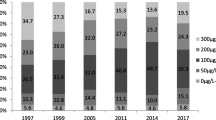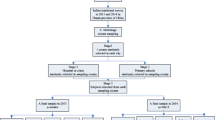Abstract
Purpose
The contribution of household cooking salt to population iodine status is decreasing in China, the applicability of the coverage rate of iodized salt (IS), proportion of adequately iodized salt (AIS), and salt iodine concentration (SIC) of household cooking salt used for iodine status assessment of residents requires further investigation.
Methods
Through the IDD control project, 16,445 children and 4848 pregnant women were recruited from Tianjin, China and the relationship between the coverage rate of IS, proportion of AIS, SIC, and population iodine status was analyzed. Additionally, through the thyroid health survey project, 856 children with IS or noniodized salt were recruited. The effects of different household cooking salts on individual iodine status and thyroid health were analyzed.
Results
After adjusting for confounding factors, no relationship was found between the coverage rate of IS, proportion of AIS, SIC of household cooking salt, and iodine status of children and pregnant women (all P > 0.05). No differences in levels of thyroid function and structural indicators were found in children with different household cooking salts (all P > 0.05). Additionally, no relationship was found between noniodized salt exposure and goiter, overt hyperthyroidism, overt hypothyroidism, thyroid nodules, antibody single positivity, or subclinical hypothyroidism (all P > 0.05).
Conclusion
Iodine in household cooking salt no longer plays a crucial role in iodine status in Tianjin, China. Other indicators must be identified as beneficial supplements for precise iodine status evaluation not only in Tianjin but also in other large cities in China.




Similar content being viewed by others
References
Li Y, Teng D, Ba J, Chen B, Du J, He L, Lai X, Teng X, Shi X, Li Y, Chi H, Liao E, Liu C, Liu L, Qin G, Qin Y, Quan H, Shi B, Sun H, Tang X, Tong N, Wang G, Zhang JA, Wang Y, Xue Y, Yan L, Yang J, Yang L, Yao Y, Ye Z, Zhang Q, Zhang L, Zhu J, Zhu M, Ning G, Mu Y, Zhao J, Shan Z, Teng W (2020) Efficacy and safety of long-term universal salt iodization on thyroid disorders: epidemiological evidence from 31 provinces of mainland China. Thyroid 30(4):568–579. https://doi.org/10.1089/thy.2019.0067
Zimmermann MB, Boelaert K (2015) Iodine deficiency and thyroid disorders. Lancet Diabetes Endocrinol 3(4):286–295. https://doi.org/10.1016/S2213-8587(14)70225-6
Walker SP, Wachs TD, Gardner JM, Lozoff B, Wasserman GA, Pollitt E, Carter JA, International Child Development Steering G (2007) Child development: risk factors for adverse outcomes in developing countries. Lancet 369(9556):145–157. https://doi.org/10.1016/S0140-6736(07)60076-2
WHO (2014) Guideline: fortification of food-grade salt with Iodine for the prevention and control of iodine deficiency disorders. World Health Organization, Geneva
Eastman CJ, Zimmermann MB (2018) The Iodine Deficiency Disorders. In: Feingold KR, Anawalt B, Boyce A et al (Eds) Endotext [Internet]. South Dartmouth (MA): MDText.com, Inc.; 2000–.
WHO, Unicef, ICCIDD (2007) Assessment of iodine deficiency disorders and monitoring their elimination. A guide for programme managers, 3rd edn. Geneva, World Health Organization
Zimmermann MB, Andersson M (2021) Global endocrinology: global perspectives in endocrinology: coverage of iodized salt programs and iodine status in 2020. Eur J Endocrinol. https://doi.org/10.1530/EJE-21-0171
The Iodine Global Network (2021) Global map of iodine nutrition (2021). IGN: Ottawa, Canada. https://www.ign.org/cm_data/IGN_Global_Scorecard_MAP_2021_SAC_-_7_May_2021.pdf. Accessed 18 July 2021
Bhat S, Marklund M, Henry ME, Appel LJ, Croft KD, Neal B, Wu JHY (2020) A systematic review of the sources of dietary salt around the world. Adv Nutr 11(3):677–686. https://doi.org/10.1093/advances/nmz134
Zhao F, Zhang P, Zhang L, Niu W, Gao J, Lu L, Liu C, Gao X (2015) Consumption and sources of dietary salt in family members in Beijing. Nutrients 7(4):2719–2730. https://doi.org/10.3390/nu7042719
Wang Z, Jin W, Zhu Z, Cui X, Song Q, Shi Z, Wu C, Zang J, Guo C (2020) Relationship of household cooking salt and eating out on iodine status of pregnant women in environmental iodine-deficient coastal areas of China. Br J Nutr 124(9):971–978. https://doi.org/10.1017/S000711452000207X
UNICEF (2018) Guidance on the monitoring of salt iodization programmes and determination of population iodine status. UNICEF, New York
The Iodine Global Network (2021) Global scorecard of iodine nutrition in 2021 in the general population based on school-age children (SAC). IGN: Ottawa, Canada. https://www.ign.org/cm_data/IGN_Global_Scorecard_2021_7_May_2021.pdf. Accessed 18 July 2021
Zhai X, Zhang L, Chen L, Lian X, Liu C, Shi B, Shi L, Tong N, Wang S, Weng J, Zhao J, Teng X, Yu X, Lai Y, Wang W, Li C, Mao J, Li Y, Fan C, Li L, Shan Z, Teng W (2018) An age-specific serum thyrotropin reference range for the diagnosis of thyroid diseases in older adults: a cross-sectional survey in China. Thyroid 28(12):1571–1579. https://doi.org/10.1089/thy.2017.0715
Fan L, Tan L, Chen Y, Du C, Zhu M, Wang K, Wei H, Wang W, Gao M, Zhang Y, Cui T, Chen W, Shen J, Zhang W (2018) Investigation on the factors that influence the prevalence of thyroid nodules in adults in Tianjin, China. J Trace Elem Med Biol 50:537–542. https://doi.org/10.1016/j.jtemb.2018.03.004
Rohrig N, Strobl R, Muller M, Perz S, Kaab S, Martens E, Peters A, Linkohr B, Grill E (2014) Directed acyclic graphs helped to identify confounding in the association of disability and electrocardiographic findings: results from the KORA-Age study. J Clin Epidemiol 67(2):199–206. https://doi.org/10.1016/j.jclinepi.2013.08.012
MacDonald CJ, Madika AL, Bonnet F, Fagherazzi G, Lajous M, Boutron-Ruault MC (2020) Consumption of cocoa-containing foods and risk of hypertension in French women. Eur J Epidemiol 35(5):465–469. https://doi.org/10.1007/s10654-020-00603-w
Lightdale JR, Mitchell PD, Fredette ME, Mahoney LB, Zgleszewski SE, Scharff L, Fox VL (2011) A pilot study of ketamine versus midazolam/fentanyl sedation in children undergoing GI endoscopy. Int J Pediatr 2011:623710. https://doi.org/10.1155/2011/623710
Barros AJ, Hirakata VN (2003) Alternatives for logistic regression in cross-sectional studies: an empirical comparison of models that directly estimate the prevalence ratio. BMC Med Res Methodol 3:21. https://doi.org/10.1186/1471-2288-3-21
Coutinho LM, Scazufca M, Menezes PR (2008) Methods for estimating prevalence ratios in cross-sectional studies. Rev Saude Publica 42(6):992–998. https://doi.org/10.1590/S0034-89102008000600003
Kernan WN, Viscoli CM, Brass LM, Broderick JP, Brott T, Feldmann E, Morgenstern LB, Wilterdink JL, Horwitz RI (2000) Phenylpropanolamine and the risk of hemorrhagic stroke. N Engl J Med 343(25):1826–1832. https://doi.org/10.1056/NEJM200012213432501
Wang Z, Zhou J, Jia X (2019) Is the cooking salt safe in China? assessment of chemical contaminants in cooking salt. Biol Trace Elem Res 191(2):512–516. https://doi.org/10.1007/s12011-019-1646-5
Gorstein JL, Bagriansky J, Pearce EN, Kupka R, Zimmermann MB (2020) Estimating the health and economic benefits of universal salt iodization programs to correct iodine deficiency disorders. Thyroid 30(12):1802–1809. https://doi.org/10.1089/thy.2019.0719
WHO, Unicef, ICCIDD (1993) Indicators for assessing iodine deficiency disorders and their control programmes: report of a Joint WHO/UNICEF/ICCIDD consultation. World Health Organization, Geneva
WHO, UNICEF, ICCIDD (2001) Assessment of iodine deficiency disorders and monitoring their elimination: a guide for programme managers, 2nd edn, Geneva Switzerland Who Department of Nutrition for Health & Development. World Health Organization, Geneva
Garcia Ascaso MT, Perez PR, Alcol EC, Lopez AL, de Lucas CC, Santos IM, Tessier E, Segura SA (2019) Nutritional status of iodine in children: when appropriateness relies on milk consumption and not adequate coverage of iodized salt in households. Clin Nutr ESPEN 30:52–58. https://doi.org/10.1016/j.clnesp.2019.02.007
UNICEF (2017) The state of the world’s children 2017: children in a digital world. UNICEF: New York, USA. https://www.unicef.org/media/48581/file/SOWC_2017_ENG.pdf. Accessed 20 July 2021
Wang Z, Zang J, Shi Z, Zhu Z, Song J, Zou S, Jin W, Jia X, Guo C, Liu S (2019) Iodine status of 8 to 10 years old children within 20 years following compulsory salt iodization policy in Shanghai. China. Nutr J 18(1):63. https://doi.org/10.1186/s12937-019-0491-x
Lou X, Wang X, Mao G, Zhu W, Mo Z, Wang Y, Wang Z (2020) Geographical influences on the iodine status in pregnant women, neonates, and school-age children in China. Nutr J 19(1):7. https://doi.org/10.1186/s12937-020-0525-4
Zimmermann MB, Andersson M (2012) Assessment of iodine nutrition in populations: past, present, and future. Nutr Rev 70(10):553–570. https://doi.org/10.1111/j.1753-4887.2012.00528.x
Rohner F, Zimmermann M, Jooste P, Pandav C, Caldwell K, Raghavan R, Raiten DJ (2014) Biomarkers of nutrition for development—iodine review. J Nutr 144(8):1322S-1342S. https://doi.org/10.3945/jn.113.181974
Rohner F, Nizamov F, Petry N, Yuldasheva F, Ismailov S, Wegmuller R, Guo S, Wirth JP, Woodruff BA (2020) Household coverage with adequately iodized salt and iodine status of nonpregnant and pregnant women in Uzbekistan. Thyroid 30(6):898–907. https://doi.org/10.1089/thy.2019.0788
Funding
This work was supported by the National Nature Science Foundation of China [81573107] and Scientific and Technological Project of Tianjin health (ZC20048).
Author information
Authors and Affiliations
Contributions
YC, YW, and GJ contributed to conceptualization. YC and DZ were involved in data curation, formal analysis, and validation. YW and HL contributed to funding acquisition. YC, YW, CH, DZ, WL, YD, and FL were involved in investigation. YC, PZ, ZC, and GJ contributed to methodology. YW, HC, HL, and GJ were responsible project administration and resources. YW and GJ performed supervision. YC was involved in visualization and writing—original draft. PZ, ZC, and GJ contributed to writing—review and editing. All the authors read and approved the final manuscript.
Corresponding author
Ethics declarations
Conflict of interest
The authors declare that there are no conflicts of interest.
Informed consent
This study was approved by the “The medical ethics committee of Tianjin Centers for Disease Control and Prevention” and has been carried out in accordance with followed the ethical guidelines set out in the Declaration of Helsinki. All the selected children agreed to participate with consent from their guardians, and the pregnant women consented to participate.
Consent to participate
All participants have consented to participate in this study.
Consent for publication
The participants have consented to the submission of the manuscript to the journal.
Supplementary Information
Below is the link to the electronic supplementary material.
394_2021_2792_MOESM2_ESM.tif
Supplementary file2 Distribution map of sample collection in Tianjin. The dot indicates that in 2016–2020 (2016–2018 for pregnant women), the IDD control project monitored at least 200 children and 100 pregnant women in the district. The triangle represents that at least 100 children and 60 pregnant women were monitored in 2016 in the IDD control project, and at least 200 children and 100 pregnant women were monitored in 2017–2020 (2017–2018 for pregnant women). The square indicates that the IDD control project was not monitored in the district in 2016, and at least 200 children and 100 pregnant women were monitored in 2017–2020 (2017–2018 for pregnant women). The red diamond represents the district where the thyroid health survey project of children exposed to different household cooking salts was performed in Tianjin (TIF 2451 KB)
394_2021_2792_MOESM3_ESM.tif
Supplementary file3 DAG of confounding factor screening for the effects of noniodized salt on thyroid abnormalities (TIF 3604 KB)
Rights and permissions
About this article
Cite this article
Cui, Y., Wang, Y., Hou, C. et al. Iodine in household cooking salt no longer plays a crucial role in iodine status of residents in Tianjin, China. Eur J Nutr 61, 2435–2449 (2022). https://doi.org/10.1007/s00394-021-02792-w
Received:
Accepted:
Published:
Issue Date:
DOI: https://doi.org/10.1007/s00394-021-02792-w




